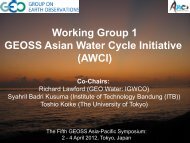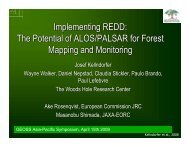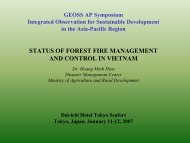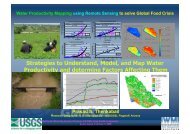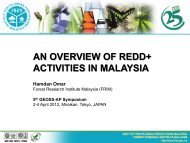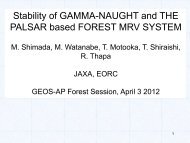Coordinating Internationally to Observe the Global Ocean for Climate
Coordinating Internationally to Observe the Global Ocean for Climate
Coordinating Internationally to Observe the Global Ocean for Climate
Create successful ePaper yourself
Turn your PDF publications into a flip-book with our unique Google optimized e-Paper software.
<strong>Coordinating</strong> <strong>Internationally</strong> <strong>to</strong> <strong>Observe</strong> <strong>the</strong><br />
<strong>Global</strong> <strong>Ocean</strong> <strong>for</strong> <strong>Climate</strong><br />
Second GEOSS Asia-Pacific Symposium<br />
Sidney Thurs<strong>to</strong>n, Ph.D.<br />
International Coordina<strong>to</strong>r, NOAA <strong>Climate</strong> Program Office<br />
National <strong>Ocean</strong>ic and Atmospheric Administration (NOAA), USA<br />
April 15, 2008<br />
Tokyo, Japan
Critical Themes<br />
• There is a lot more low frequency variability in <strong>the</strong> ocean than we'd realized and continuous<br />
sampling <strong>for</strong> many decades is needed <strong>to</strong> get decent estimates of long term trends.<br />
• Interannual <strong>to</strong> decadal ocean variability is going <strong>to</strong> affect society much more strongly than<br />
climate change over <strong>the</strong> next few decades. IPCC wants <strong>to</strong> have a component on decadal<br />
projection <strong>for</strong> AR5...<strong>the</strong>se model runs will depend strongly on ocean initial conditions.<br />
• Satellites simply cannot do <strong>the</strong> moni<strong>to</strong>ring job of <strong>the</strong> world’s oceans. The need <strong>for</strong> in situ<br />
observations is critical. Much of <strong>the</strong> critical climate <strong>for</strong>ecasting in<strong>for</strong>mation comes from <strong>the</strong><br />
subsurface ocean...carbon, heat, salinity, sea level contributions, overturning<br />
circulations...also things <strong>the</strong> satellites cannot moni<strong>to</strong>r. The same <strong>for</strong> ecosystem and<br />
biogeochemistry variables<br />
• The operational and climate communities have been doing Observing System Sensitivity<br />
Experiments (OSSE) work <strong>to</strong> evaluate <strong>the</strong> GCOS/UNFCCC/GEO ocean plan and present<br />
conclusions are that <strong>the</strong> plan continues <strong>to</strong> be <strong>the</strong> minimum needed, with clear cases <strong>to</strong> be<br />
made <strong>for</strong> enhancements, Engagement by new Member Nations and closer collaborations.<br />
• One Final key point <strong>to</strong> keep in mind is that GEOSS is an “end-<strong>to</strong>-end” concept, meaning that<br />
it is not just about data, but <strong>the</strong> delivery of useful in<strong>for</strong>mation <strong>for</strong> meaningful decision<br />
making. NOAA is adopting this approach <strong>for</strong> global ocean observations, as you will see, and<br />
we encourage o<strong>the</strong>rs <strong>to</strong> consider ways <strong>to</strong> pursue this.
Wea<strong>the</strong>r<br />
Watches, warnings,<br />
floods, hurricanes,<br />
Wea<strong>the</strong>r Radio...<br />
<strong>Ocean</strong><br />
Coral reefs, tides,<br />
currents, buoys,<br />
marine sanctuaries,<br />
estuaries, diving, spills<br />
Satellites<br />
Real-time imagery,<br />
environmental,<br />
geostationary and<br />
polar satellites<br />
Fisheries<br />
Protecting marine mammals,<br />
sea turtles, habitats,<br />
statistics, economics,<br />
en<strong>for</strong>cement<br />
<strong>Climate</strong><br />
El Niño & La Niña, global<br />
warming, drought, climate<br />
prediction, archived wea<strong>the</strong>r<br />
data, paleoclima<strong>to</strong>logy<br />
Research<br />
Environmental labs, air<br />
quality, atmospheric<br />
processes, climate and<br />
human interactions<br />
Coasts<br />
Coastal services &<br />
products, Great Lakes,<br />
coastal zone<br />
management<br />
Charting &<br />
Navigation<br />
Nautical & navigational<br />
charts, mapping, remote<br />
sensing, safe navigation
International Objectives<br />
• Optimize Cost-effective resource sharing <strong>for</strong> Shiptime,<br />
instrumentation, CPU time, etc.<br />
• Enhance Regional Capacity and Training <strong>for</strong> Socio-economic<br />
Benefits<br />
• Eliminate Gaps and Overlap Redundancies<br />
• Coordinate Joint Implementation<br />
• Ensure Free, Open and Timely Access <strong>to</strong> Data
End User Requirements<br />
• <strong>Climate</strong>:<br />
• Operational Forecast<br />
Centers<br />
• International Research<br />
Programs<br />
• Major Scientific<br />
Assessments<br />
• System designed <strong>to</strong> meet<br />
climate requirements but<br />
also supports:<br />
• Wea<strong>the</strong>r prediction<br />
• <strong>Global</strong> and coastal ocean<br />
prediction<br />
• Marine hazards warning<br />
• Transportation<br />
• Marine environment and<br />
ecosystem moni<strong>to</strong>ring<br />
• Tide gauge stations<br />
• Drifting Buoys<br />
• Tropical Moored<br />
Buoys<br />
• Profiling Floats<br />
• Ships of Opportunity<br />
• <strong>Ocean</strong> Reference<br />
Stations<br />
• <strong>Ocean</strong> Carbon<br />
Networks<br />
• Arctic Observing<br />
System<br />
• Dedicated Ship<br />
Support<br />
• Data & Assimilation<br />
Subsystems<br />
• Management and<br />
Product Delivery<br />
• Satellites (managed<br />
outside of IOOS)
International Partnerships<br />
are Central<br />
A global system by definition crosses<br />
international boundaries<br />
NOAA’s s contributions are managed in<br />
cooperation with <strong>the</strong> Joint WMO/IOC Technical<br />
Commission <strong>for</strong> <strong>Ocean</strong>ography and Marine<br />
Meteorology (JCOMM) -- presently 68 nations.
The organizing framework is in place<br />
All Six global in situ<br />
implementation programs are<br />
now linked internationally<br />
through WMO/IOC JCOMM<br />
coordination
Tide Gauge<br />
Stations<br />
Surface Drifting<br />
Buoys<br />
Tropical Moored<br />
Buoys<br />
Ships of<br />
Opportunity<br />
Argo Floats<br />
<strong>Ocean</strong> Reference<br />
Stations<br />
Arctic <strong>Ocean</strong><br />
System<br />
<strong>Ocean</strong> Carbon<br />
Network<br />
Dedicated Ship<br />
Time<br />
2004 2005 2006 2007 2008<br />
2009 2010 2011 2012<br />
59<br />
787<br />
510<br />
458<br />
61<br />
2240<br />
1120<br />
458<br />
71<br />
34<br />
1021<br />
83 86 91<br />
27<br />
16<br />
1572<br />
41 42<br />
13<br />
Percent Complete Index:<br />
Total System<br />
9<br />
48<br />
1250<br />
1000<br />
39<br />
19<br />
24<br />
14<br />
41<br />
19<br />
2557<br />
1263<br />
43<br />
17<br />
18<br />
468<br />
85<br />
48<br />
965<br />
68<br />
1741<br />
20<br />
20<br />
6<br />
492<br />
101<br />
48<br />
1000<br />
75<br />
7<br />
21<br />
22<br />
8<br />
492<br />
101<br />
1000<br />
77<br />
21<br />
26<br />
10<br />
113<br />
1125<br />
77<br />
41 43<br />
19<br />
21<br />
14<br />
492<br />
23<br />
59<br />
35<br />
29<br />
11<br />
552<br />
1125<br />
77<br />
133<br />
1125<br />
77<br />
43 43<br />
21<br />
21<br />
Representative miles<strong>to</strong>nes including international contributions<br />
2004 2005 2006<br />
Multi-Year Phased Implementation Plan (NOAA)<br />
15 17<br />
46 4<br />
21<br />
11 14 14<br />
48<br />
47<br />
21 38<br />
123<br />
23<br />
42<br />
35<br />
13<br />
552<br />
72<br />
23<br />
42<br />
35<br />
15<br />
552<br />
81<br />
2013 2014<br />
145<br />
1125<br />
77<br />
21<br />
23<br />
42<br />
35<br />
17<br />
552<br />
158<br />
58 63 67 70 72<br />
1294 1258 1250 1250 1375 1375 1375 1375 1375<br />
1125<br />
97 103 112 112 115 117 118 119<br />
41<br />
19<br />
3055<br />
41<br />
19<br />
43 43<br />
77<br />
43 45 45<br />
21<br />
23<br />
42<br />
35<br />
18<br />
552<br />
89 98<br />
Goal<br />
170<br />
84<br />
1375<br />
1125<br />
131<br />
3000 3000 3000 3000 3000 3000 3000 3000<br />
1500<br />
1500<br />
59 59 60<br />
1500<br />
1500<br />
1500<br />
1500<br />
1500<br />
89<br />
51<br />
23<br />
1500<br />
50 51 52 55 58 87<br />
64<br />
31<br />
34<br />
37<br />
31<br />
73<br />
42<br />
37 37<br />
18<br />
882<br />
100<br />
Real-time Stations,<br />
Initial GCOS Subset<br />
Number of buoys<br />
Number of moorings<br />
High resolution & frequently<br />
repeated lines occupied<br />
Number of floats<br />
Number of observa<strong>to</strong>ries<br />
and ocean reference stations<br />
Ice buoys, drifting and<br />
moored stations, transects<br />
Repeat Sections completed,<br />
one inven<strong>to</strong>ry per 10 years<br />
Days at sea (NOAA contribution)<br />
International System<br />
NOAA Contributions<br />
Base Budget<br />
FY 10 Request<br />
Additional Resources Needed<br />
55 57<br />
55 56 59 6059<br />
6059<br />
64 65 66 67 68 100% Requirement<br />
Current Programming<br />
2006 2007 2008<br />
2009 2010 2011 2012<br />
2013 2014<br />
Goal<br />
3/17/08
Japan Marine-Earth Science and Technology<br />
Center (JAMSTEC)<br />
and Institute of Observational Research <strong>for</strong><br />
<strong>Global</strong> Change (IORGC)
US and Japan Tropical<br />
Moored Buoys
US Japan Argo Deployments
A Schematic Diagram of <strong>the</strong> IOD Influence<br />
on <strong>the</strong> Summer Conditions in <strong>the</strong> Nor<strong>the</strong>rn Hemisphere
IOGOOS/CLIVAR Indian <strong>Ocean</strong><br />
Observing System (IndOOS)<br />
Emphasis on ocean,<br />
but will provide surface<br />
met data as well<br />
Mooring Array<br />
Argo floats 3°x 3°<br />
Drifters 5°x 5°<br />
Carbon/hydro cruise<br />
High density XBT<br />
Frequently repeated XBT<br />
~20 real-time tide<br />
gauges <strong>for</strong> IOTWS<br />
Enhanced XBT lines <strong>to</strong> moni<strong>to</strong>r<br />
Indonesian Throughflow, inflow <strong>to</strong><br />
western boundary, Java upwelling and<br />
10°S <strong>the</strong>rmocline ridge<br />
Regional mooring arrays
Strategy <strong>for</strong> Indian <strong>Ocean</strong><br />
Moored Buoy Array<br />
• Basin scale, tropical upper<br />
ocean (500 m) focus.<br />
• Arabian Sea, Bay of<br />
Bengal, Eq. Waveguide,<br />
Thermocline ridge (5°-10°S),<br />
subtropical subduction, Java<br />
upwelling.<br />
• Does not sample western<br />
boundary currents, ITF,<br />
coastal zones.<br />
• Design supported by<br />
numerical model observing<br />
system studies.<br />
Designed by <strong>the</strong> CLIVAR/GOOS Indian <strong>Ocean</strong> Panel<br />
http://eprints.so<strong>to</strong>n.ac.uk/20357/01/IOP_Impl_Plan.pdf
Challenges: Ship Time<br />
Requirements:<br />
• ≥ 140 days per year <strong>to</strong> maintain full array<br />
• Must be available routinely and with<br />
regularity<br />
• Assumes 1-year mooring design lifetime<br />
and annual servicing cruises<br />
*Actual sea days in 2006: involves more than<br />
just mooring work
India’s Ministry of<br />
Earth Sciences (MoES)
RV Sagar Kanya Cruise<br />
Oc<strong>to</strong>ber-November 2004, 2006, 2007<br />
• National Institute <strong>for</strong><br />
<strong>Ocean</strong>ography (NIO) and NOAA-<br />
PMEL<br />
• 3 ATLAS & 1 ADCP Mooring 1.5°S,<br />
0°, 1.5°N along 80.5°E<br />
• ATLAS enhanced with current<br />
meters, salinity, rainfall, SW; in<br />
addition, LW & atmospheric pressure<br />
on central mooring<br />
• Expect <strong>to</strong> continue and expand with<br />
0<br />
Indian (NIO, NIOT, DOD/NCAOR,<br />
-5<br />
etc) and o<strong>the</strong>r institutions.<br />
-10<br />
40 45 50 55 60 65 70 75 80 85 90 95 100<br />
Latitude (°N)<br />
30<br />
25<br />
20<br />
15<br />
10<br />
5<br />
TAO moorings<br />
OOS moorings<br />
Longitude (°E)<br />
INDIA<br />
ADCP<br />
Proposed locations of <strong>the</strong> PMEL TAO and ADCP moorings (red dots)<br />
along with <strong>the</strong> existing Indian OOS mooring locations (blue open circles).<br />
Also proposed are <strong>the</strong> hydrographic stations between 2°N and 2°S<br />
at 0.5° interval along 80.5°E.
Goa India, Western Indian<br />
<strong>Ocean</strong> Workshop
Overview Of MoES-NOAA Partnership<br />
<strong>for</strong> Earth Observations<br />
and Earth Sciences<br />
• Based on Science Drivers & Societal Applications<br />
• Broad Memorandum of Understanding (MOU)<br />
– Purpose and Objectives<br />
– Scope of Cooperative Activities<br />
• RAMA Implementing Arrangement (IA)<br />
– Responsibilities<br />
– Principals
Deployment Plan with Ministry of Earth<br />
Sciences <strong>for</strong> 2008
Indonesia’s s Ministry of Marine and Fisheries<br />
(DKP) and Agency <strong>for</strong> Assessment and<br />
Application of Technology (BPPT)
APEC <strong>Ocean</strong> Ministerial MEETING (AOMM-2)<br />
Bali, Indonesia September 2005<br />
• 20 APEC <strong>Ocean</strong> Ministers Met in<br />
Kuta Bali<br />
• “Our Coast, Our <strong>Ocean</strong>… an<br />
Action Plan <strong>for</strong> Sustainability”<br />
• “Bali Action Plan”<br />
• DKP-NOAA Ministerial Bilateral<br />
Discussions<br />
• NOAA-DKP Letter of Intent<br />
Signed
Bali Indonesia PANGEA Workshop<br />
June 2006
Bandung Indonesia September 2006<br />
• Fisheries Applications<br />
of <strong>Ocean</strong> Data<br />
• Modeling and<br />
Assimilation<br />
• Bandung Institute of<br />
Technology
RANET Infrastructure Development Workshop<br />
Bali September 2007<br />
Chlorophyll<br />
Sea Surface Temperature
NOAA’s s 2008 Investment<br />
in Regional <strong>Ocean</strong> Observations<br />
ATLAS <strong>Climate</strong> & DART Tsunami Moorings<br />
Indonesian Throughflow Moni<strong>to</strong>ring<br />
X<br />
X<br />
X<br />
X
US/Indonesia Moorings on JCOMMOPS<br />
WebSite
South Africa Wea<strong>the</strong>r Service<br />
• Broached Partnership<br />
During IOP-4 4 in<br />
Pre<strong>to</strong>ria April 2007<br />
• Scoping Workshop<br />
November 2007
<strong>Ocean</strong> Acidification<br />
Since <strong>the</strong> beginning of <strong>the</strong> industrial age, <strong>the</strong> pH and CO 2 chemistry<br />
of <strong>the</strong> oceans (ocean acidification) have been changing because of<br />
<strong>the</strong> uptake of anthropogenic CO 2 by <strong>the</strong> oceans. These changes in pH<br />
and carbonate chemistry may have serious impacts on open ocean and<br />
coastal marine ecosystems.<br />
400<br />
8.38<br />
375<br />
8.33<br />
8.28<br />
CO 2<br />
350<br />
8.23<br />
pH<br />
325<br />
8.18<br />
8.13<br />
300<br />
8.08<br />
275<br />
8.03<br />
1950 1960 1970 1980 1990 2000 2010 2020<br />
Year
Predictions of <strong>Ocean</strong> Acidification and<br />
<strong>the</strong> effects on coral reef calcification<br />
Coral Reef<br />
calcification<br />
• 1765 Adequate<br />
• 2000 Marginal<br />
• 2100 Low<br />
Calcification<br />
rates in <strong>the</strong><br />
tropics may<br />
decrease by<br />
30% over <strong>the</strong><br />
next century<br />
After Feely et al (in press) with Modeled Saturation Levels from Orr et al (2005)
Observing System Challenges<br />
NOAA<br />
Missions<br />
Programs<br />
& Services<br />
(10’s)<br />
Observing<br />
Systems<br />
(~100)<br />
Observing<br />
Parameters<br />
(100’s)<br />
Moni<strong>to</strong>ring &<br />
Prediction<br />
Stewardship<br />
Wea<strong>the</strong>r<br />
<strong>Climate</strong><br />
Charting<br />
Fisheries<br />
Mgmt<br />
Homeland<br />
Security<br />
…<br />
Precipitation<br />
<strong>Ocean</strong> Salinity<br />
Solar Radiation<br />
Sea Surface<br />
Temperature<br />
Sea Height<br />
S<strong>to</strong>ck Assessment<br />
Shoreline<br />
Aerosols<br />
…
Multiple Dimensions of <strong>the</strong><br />
Problem<br />
Stakeholder Requirements<br />
Observing<br />
Systems<br />
Buoys<br />
Radar<br />
Satellite<br />
Environmental Parameters
Temporal & Geospatial<br />
Complexity<br />
Temporal<br />
Characteristics<br />
T3<br />
T2<br />
T1<br />
Geospatial<br />
Characteristics
The NOSA Conceptual Framework<br />
Support<br />
Owner<br />
Larger<br />
System<br />
is controlled by<br />
Observation<br />
Control System<br />
supported<br />
by<br />
owned<br />
by<br />
part of<br />
provides data directly <strong>to</strong><br />
located<br />
at<br />
Opera<strong>to</strong>r<br />
Plat<strong>for</strong>m /<br />
Station<br />
Location<br />
operated by<br />
is<br />
situated on<br />
Observing<br />
System<br />
Sensing<br />
Element<br />
contains<br />
is a<br />
provides<br />
data <strong>to</strong><br />
measures<br />
Environmental<br />
Parameter<br />
Data Handling<br />
System<br />
< drives<br />
provides<br />
info <strong>to</strong><br />
User<br />
Stakeholder<br />
is type<br />
of<br />
has<br />
Fixed<br />
Mobile<br />
Sensor<br />
Human<br />
characterizes<br />
Stakeholder<br />
Requirement<br />
Space<br />
Air<br />
Ground<br />
<strong>Ocean</strong><br />
Space<br />
Air<br />
Ground<br />
<strong>Ocean</strong><br />
Environmental<br />
Phenomenon<br />
< drives<br />
Basic Service<br />
Requirement<br />
< drives
Prospectus: Enhanced Planning and Coordination<br />
of <strong>Ocean</strong> Observations are Needed <strong>for</strong> GEOSS<br />
Asia-Pacific Region<br />
• Jointly Coordinate National Plans<br />
• Assess User Requirements<br />
• Assess Capabilities & Resources<br />
• Coordinate Applications, Assimilation and<br />
Modelling<br />
• Coordinate and Share Resources
“<br />
“Pacific-Indian <strong>Ocean</strong><br />
Observations <strong>for</strong> Applications”<br />
TIOOA<br />
(Eight Co-Chairs)<br />
Capabilities<br />
Subgroup<br />
User Requirements<br />
Subgroup<br />
Resource<br />
Coordination<br />
Working<br />
Group<br />
Data Management<br />
Working Group<br />
Applications of<br />
Data <strong>for</strong> Society<br />
Working Group<br />
<strong>Ocean</strong><br />
Observations<br />
Working Group<br />
Modelling/<br />
Assimilation<br />
Working Group<br />
Joint Strategic<br />
Planning<br />
Working Group
Concluding Remarks<br />
• Sustainable capacity building fosters both an increase in<br />
observations while developing <strong>the</strong> socio-economic applications<br />
of <strong>the</strong> data<br />
• We have been successful in incorporating end-<strong>to</strong><br />
<strong>to</strong>-end<br />
observational data and in<strong>for</strong>mation in<strong>to</strong> GEOSS. Still, <strong>the</strong><br />
observation data being collected <strong>to</strong>day is just a fraction of what<br />
could be available through data sharing, collaboration, and<br />
leveraging each o<strong>the</strong>rs’ investments. We need <strong>to</strong> have vision.
Concluding Remarks<br />
• The ocean/meteorological community is already <strong>the</strong><br />
ambassador <strong>for</strong> enhanced integrated observing<br />
programs <strong>to</strong> save lives, protect property, and support<br />
sustainable development. We must now reach beyond<br />
our existing networks <strong>to</strong> health, <strong>to</strong>urism, agriculture and<br />
o<strong>the</strong>r ministries as ambassadors <strong>for</strong> achieving results <strong>for</strong><br />
society across economic sec<strong>to</strong>rs and national boundaries.<br />
• No one country can achieve GEO benefits alone. Thus,<br />
we ask that you reach out within your own country and<br />
with o<strong>the</strong>r countries <strong>to</strong> become participants in GEO.
Thank You<br />
NOAA Office of <strong>Climate</strong> Observation (OCO)<br />
Sidney.Thurs<strong>to</strong>n@NOAA.gov



